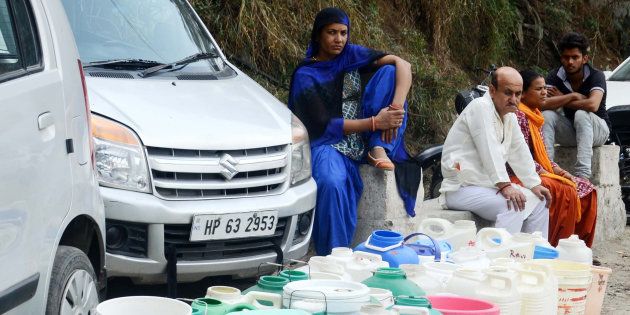
A water-contamination episode nearly two years ago could have contributed Shimla's ongoing water crisis, according to experts.
In what is supposed to be peak tourist season at the hill station that hosted 153 lakh tourists in the first 9 months of 2017, drought struck residents are pleading tourists to not visit and add to the town's misery.
Authorities claim the water supply has improved in the last 10 days, but a resident told Reuters, "We have had water last Monday after eight days and now there is no supply again. Crisis still looms and has not been dealt with effectively."
Shimla faces water shortages every year due to persistent long-term factors, but this year's crisis appears particularly acute thanks to a perfect storm of poor planning, and knee jerk policy making.
What led to the water crisis?
"The main water source for Shimla used to be springs and small streams originating from forests and the hills," Himanshu Thakkar, coordinator for South Asia Network on Dams, Rivers & People, told Huffpost India. "Two years ago between December 2015 and March 2016 there was a Hepatitis epidemic that was cause by contaminated water from Ashwami Khad -- a spring from where Shimla used to get its largest share of water."
The Himachal Pradesh High Court, Thakkar said, put a blanket ban on use of water from springs around Shimla after unclean water from a sewage treatment plant contaminated the streams, resulting in an outbreak of jaundice that affected more than 500 people in the city.
Sludge from a treatment plant at Malyana, which had a faulty sewage treatment system, was flowing into the Ashwani Khad.
Apart from Ashwani Khad, Shimla also gets its water from Gumma, Giri, Churta and Seog.
An Indian Express report from 2016 pointed out that since major reservoirs were not being used, Shimla was heading for a crisis. The Irrigation and Public Health Department had also shut down the Chair and Cherot reservoirs because of bad quality of water, the report had said.
The fact the administration has done little to compensate for the loss of reservoir water, may have led to the current crisis. Shimla, located at the ridge of the Sutlej and Yamuna basins, requires 45 million litres of water daily (MLD) and it is only getting 18 MLD at the moment.
"They have made no amends after Shimla stopped getting water from its streams," Thakkar said.
Thakkar also said that "haphazard urbanisation" and "wasteful use of water" were also to be blamed for the present situation in Shimla.
The infrastructure of Shimla was built by the British in 1875 for a population of 16,000 people, but at the moment there are about 2,00,000 residents in the biggest city of Himachal Pradesh, add to that about 3 lakh tourists who visit the city each year.
The increasing population isn't the only reason to blame for the present crisis.While the government had planned to set up a committee, under the chief secretary, 3 years ago, to get a loan from the World Bank which would finance lifting of 104 MLD of Sutlej water from the Kol Dam, such a committee has not been set up.
Lack of snowfall and rainfall last year has also added to the problem.
What are the solutions for Shimla?
Thakkar said of lifting water won't be of help in the long run.
"Lifting water to a huge height is not cost effective. They must ensure that sewage does not get mixed with water through decentralised sewage treatment plants," he said. "Moreover, water from sewage treatment plants can be used for non-potable purposes like constructions, watering gardens."
Water needs to be looked at as a eco-system and not a a commodity in a decentralised manner.
"Water is an ecosystem that gets no attention from the government," he said.
The larger water problem in India
Amid the major water crisis in Shimla, reports suggest that taps in some parts of Uttar Pradesh and Rajasthan are running dry. Delhi too is may face water shortage soon.
Thakkar said, "Delhi is always on the brink of a water crisis."
He said while the government promotes rainwater harvesting, "how many government buildings have rainwater harvesting facilities in Delhi?"
The problem, he said, is deeper than just bringing water from point A to point B during a crisis.
According to Thakkar 85% of India's irrigation water, 55% of urban water and nearly 50% of industrial water comes from India's ground water reserves and that India is the largest user of ground water reserves in the world.
"Earlier during deficit monsoon, ground water used to be our back up, now it has become our mainstay. This is unsustainable. The government must come up with the policy to sustain ground water levels that are running low across the country. Each place gets its water from different resources, the government must identify such resources and formulate a policy to protect forests, water bodies and reserves -- the ground water recharge systems that face destruction."
He warns that there are several levels of water crisis across India and it is spreading and increasing in intensity.
"The most common reason is that in India the water business is government business and even if communities try to bring attention to the government, they did not pay heed," Thakkar said.